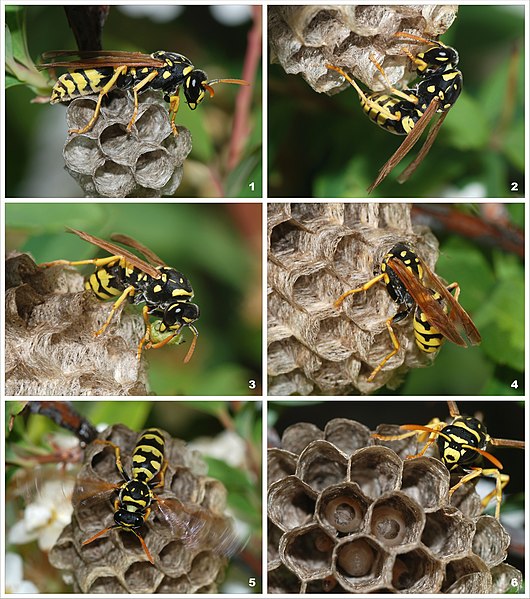Paypay:Wasp colony.jpg

Kadako hin nga pahiuna nga pagawas: 530 × 599 nga mga pixel. Iba nga mga resolusyon: 212 × 240 nga mga pixel | 424 × 480 nga mga pixel | 679 × 768 nga mga pixel | 906 × 1,024 nga mga pixel | 1,811 × 2,048 nga mga pixel | 3,291 × 3,721 nga mga pixel.
Orihinal nga paypay (3,291 × 3,721 nga pixel, kadako han fayl: 6.45 nga MB, MIME nga tipo: image/jpeg)
Kaagi han paypay
Pidlita an adlaw/oras para makit-an an fayl nga naggawas hito nga oras.
| Pitsa/Oras | Thumbnail | Mga dimensyon | Gumaramit | Komento | |
|---|---|---|---|---|---|
| waray pa kasasapawi | 19:00, 12 Abril 2008 |  | 3,291 × 3,721 (6.45 nga MB) | Alvesgaspar | {{Information |Description=A young paper wasp queen (''Polistes dominulus'') founding a new colony<br> '''1''' - The nest with only a few cells <br> '''2''' - New cells being made with mashed fibers and saliva <br> '''3''' - A caterpillar was caught and i |
Mga Sumpay
An mga nasunod nga mga pakli nasumpay hini nga paypay:
Global file usage
An masunod nga iba nga mga wiki in nagamit hini nga file:
- Paggamit ha ast.wikipedia.org
- Paggamit ha ban.wikipedia.org
- Paggamit ha bg.wikipedia.org
- Paggamit ha bn.wikipedia.org
- Paggamit ha ceb.wikipedia.org
- Paggamit ha ce.wikipedia.org
- Paggamit ha crh.wikipedia.org
- Paggamit ha cv.wikipedia.org
- Paggamit ha en.wikipedia.org
- Paper wasp
- User:Alvesgaspar
- Wikipedia:Featured pictures/Animals/Insects
- Polyembryony
- Wikipedia:Featured pictures thumbs/11
- Wikipedia:Featured picture candidates/April-2008
- Wikipedia:Wikipedia Signpost/2008-04-21/Features and admins
- Wikipedia:Featured picture candidates/Image:Wasp colony.jpg
- Wikipedia:Wikipedia Signpost/2008-04-21/SPV
- User:Daniel Mietchen/Science communication gallery
- Wikipedia:Picture of the day/May 2009
- Template:POTD/2009-05-16
- User:Michel Mapaliey/Flower
- User talk:Alvesgaspar/archive1
- Structures built by animals
- User:Shockenheimer
- User:Garnhami/sandbox
- Wikipedia:Wikipedia Signpost/Single/2008-04-21
- Paggamit ha eo.wikipedia.org
- Paggamit ha es.wikipedia.org
- Paggamit ha fa.wikipedia.org
- Paggamit ha fr.wikipedia.org
- Paggamit ha fr.wiktionary.org
- Paggamit ha gl.wikipedia.org
- Paggamit ha he.wikipedia.org
- Paggamit ha hu.wikipedia.org
- Paggamit ha id.wikipedia.org
- Paggamit ha is.wikipedia.org
- Paggamit ha it.wikipedia.org
- Paggamit ha ja.wikipedia.org
- Paggamit ha jv.wikipedia.org
- Paggamit ha kk.wikipedia.org
- Paggamit ha ko.wikipedia.org
- Paggamit ha lbe.wikipedia.org
- Paggamit ha mk.wikipedia.org
- Paggamit ha ml.wikipedia.org
Kitaa durudamo nga global usage hinin nga file.








